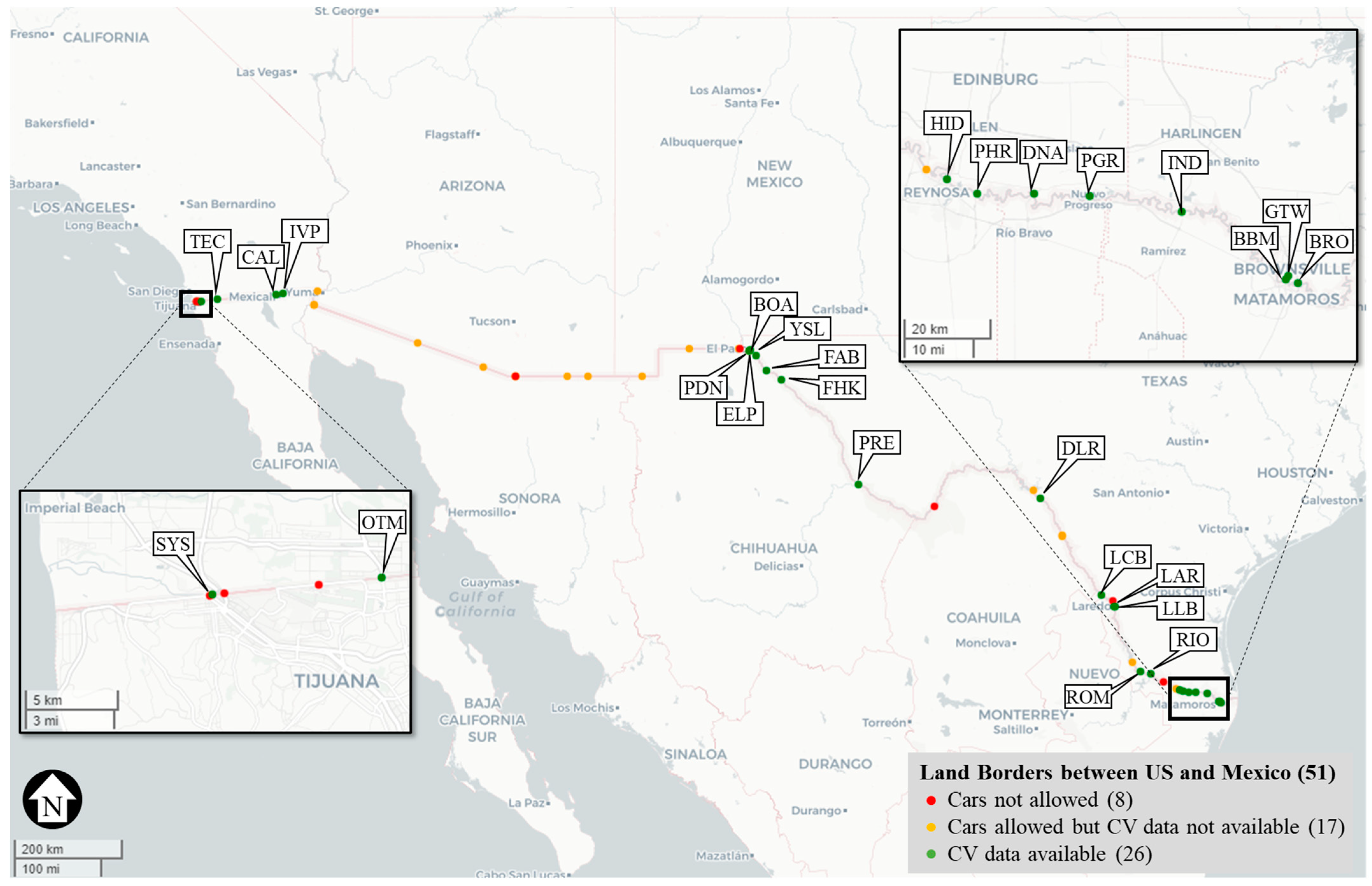Methodology for Monitoring Border Crossing Delays with Connected Vehicle Data: United States and Mexico Land Crossings Case Study
Abstract
1. Introduction
2. Literature Review
2.1. Land Border Crossing Performance Measurement Technology
2.2. Emerging Connected Vehicle Technology
3. Paper Objective
- Border crossings and select locations analyzed during this study (Section 4).
- Connected Vehicle data attributes available for analysis (Section 5).
- Scalable methodology for identifying trips and corresponding travel time (Section 6).
- Results from the analysis and graphics for agencies (Section 7).
- Summary of trips detected by location and direction (Section 7.1).
- Estimating travel time delay individually for identified trips (Section 7.2).
- Comparison of travel delays at border crossings (Section 7.3)
- Ranking the border crossings using four metrics (Section 7.4)
- Metric 1—Total trip counts by direction (Section 7.4.1)
- Metric 2—Median travel delay by direction (Section 7.4.2)
- Metric 3—Top Five border crossings with most trips with delays greater than 5 min (Section 7.4.3).
- Metric 4—Total cumulative travel delays (Section 7.4.4).
- Actionable insights from delay trends by Time of Day and Day of Week (Section 7.5).
- Conclusions (Section 8).
4. Study Locations
5. Data Description
6. Methodology
7. Results
7.1. Summary of Trips Detected
7.2. Travel Time Delay Estimation
7.3. Delays at Border Crossings
7.4. Border Crossings Rankings
7.4.1. Trip Counts
7.4.2. Median Delay
7.4.3. Delayed Trip Counts
7.4.4. Total Cumulative Delay
7.5. Delay Trends by Time of Day and Day of Week
8. Conclusions
Author Contributions
Funding
Institutional Review Board Statement
Informed Consent Statement
Data Availability Statement
Acknowledgments
Conflicts of Interest
References
- Secretaría de Relaciones Exteriores. National Trade 2022. Available online: https://embamex.sre.gob.mx/eua/index.php/en/economic-affairs-2022/1914-trade-by-state-2022 (accessed on 29 August 2023).
- U.S. Census Bureau. Trade in Goods with Mexico. Available online: https://www.census.gov/foreign-trade/balance/c2010.html (accessed on 29 August 2023).
- U.S. Census Bureau. Top Trading Partners-June 2023. Available online: https://www.census.gov/foreign-trade/statistics/highlights/topcm.html (accessed on 29 August 2023).
- Blecker, R.A. The Mexican and U.S. Economies After Twenty Years of NAFTA. Int. J. Polit. Econ. 2015, 43, 5–26. [Google Scholar] [CrossRef]
- Office of the United States Trade Representative. Agreement between the United States of America, the United Mexican States, and Canada 7/1/20 Text. Available online: https://ustr.gov/trade-agreements/free-trade-agreements/united-states-mexico-canada-agreement/agreement-between (accessed on 17 November 2023).
- Bureau of Transportation Statistics. Border Crossing/Entry Data. Available online: https://www.bts.gov/browse-statistical-products-and-data/border-crossing-data/border-crossingentry-data (accessed on 29 August 2023).
- Polus, A. A study of travel time and reliability on arterial routes. Transportation 1979, 8, 141–151. [Google Scholar] [CrossRef]
- Lomax, T.; Turner, S.; Margiotta, R. Monitoring Urban Roadways in 2000: Using Archived Operations Data for Reliability and Mobility Measurement. FHWA-OP-02-029. 2001. Available online: https://rosap.ntl.bts.gov/view/dot/41412 (accessed on 16 November 2023).
- Haseman, R.J.; Wasson, J.S.; Bullock, D.M. Real-Time Measurement of Travel Time Delay in Work Zones and Evaluation Metrics Using Bluetooth Probe Tracking. Transp. Res. Rec. 2010, 2169, 40–53. [Google Scholar] [CrossRef]
- Miltiadou, M.; Bouhouras, E.; Basbas, S.; Mintsis, G.; Taxiltaris, C. Analysis of border crossings in South East Europe and measures for their improvement. Transp. Res. Procedia 2017, 25, 603–615. [Google Scholar] [CrossRef]
- Paselk, T.A.; Mannering, F.L. Use of duration models for predicting vehicular delay at a US/Canadian border crossing. Transportation 1994, 21, 249–270. [Google Scholar] [CrossRef]
- Turner, S.M.; Eisele, W.L.; Benz, R.J.; Holdener, D.J. Travel Time Data Collection Handbook; No. FHWA-PL-98-035; USDOT’s National Transportation Library: Washington, DC, USA, 1998. [CrossRef]
- Kazagli, E.; Koutsopoulos, H.N. Estimation of Arterial Travel Time from Automatic Number Plate Recognition Data. Transp. Res. Rec. 2013, 2391, 22–31. [Google Scholar] [CrossRef]
- Clark, S.D.; Grant-Muller, S.; Chen, H. Cleaning of Matched License Plate Data. Transp. Res. Rec. J. Transp. Res. Board 2002, 1804, 1–7. [Google Scholar] [CrossRef]
- Takaba, S.; Morita, T.; Hada, T.; Usami, T.; Yamaguchi, M. Estimation and measurement of travel time by vehicle detectors and license plate readers. In Proceedings of the Vehicle Navigation and Information Systems Conference, Troy, MI, USA, 20–23 October 1991; pp. 257–267. [Google Scholar] [CrossRef]
- Li, Z.; Li, N.; Liu, F.; Liu, Y. Short-term forecasting of travel time based on license plate matching data. In Proceedings of the 2008 IEEE International Conference on Automation and Logistics, Qingdao, China, 1–3 September 2008; pp. 1390–1395. [Google Scholar] [CrossRef]
- Jenelius, E.; Koutsopoulos, H.N. Travel time estimation for urban road networks using low frequency probe vehicle data. Transp. Res. Part B Methodol. 2013, 53, 64–81. [Google Scholar] [CrossRef]
- Li, Y.; McDonald, M. Link travel time estimation using single GPS equipped probe vehicle. In Proceedings of the IEEE 5th International Conference on Intelligent Transportation Systems, Singapore, 3–6 September 2002; pp. 932–937. [Google Scholar] [CrossRef]
- Hellinga, B.; Fu, L. Assessing Expected Accuracy of Probe Vehicle Travel Time Reports. J. Transp. Eng. 1999, 125, 524–530. [Google Scholar] [CrossRef]
- Srinivasan, K.K.; Jovanis, P.P. Determination of Number of Probe Vehicles Required for Reliable Travel Time Measurement in Urban Network. Transp. Res. Rec. J. Transp. Res. Board 1996, 1537, 15–22. [Google Scholar] [CrossRef]
- Alonso, B.; Musolino, G.; Rindone, C.; Vitetta, A. Estimation of a Fundamental Diagram with Heterogeneous Data Sources: Experimentation in the City of Santander. ISPRS Int. J. Geo-Inf. 2023, 12, 418. [Google Scholar] [CrossRef]
- McCormack, E.; Hallenbeck, M.E. ITS Devices Used to Collect Truck Data for Performance Benchmarks. Transp. Res. Rec. J. Transp. Res. Board 2006, 1957, 43–50. [Google Scholar] [CrossRef]
- Turner, S.M. Advanced Techniques for Travel Time Data Collection. Transp. Res. Rec. 1996, 1551, 51–58. [Google Scholar] [CrossRef]
- Bailey, M.D. A Computerized Travel Time Study for Northeastern Illinois: Methodology and Commentary; Chicago Area Transportation Study: Chicago, IL, USA, 1991; Volume 91.
- Sakhare, R.S.; Vanajakshi, L. Reliable corridor level travel time estimation using probe vehicle data. Transp. Lett. 2020, 12, 570–579. [Google Scholar] [CrossRef]
- Araghi, B.N.; Christensen, L.T.; Krishnan, R.; Lahrmann, H. Application of Bluetooth Technology for Mode- Specific Travel Time Estimation on Arterial Roads: Potentials and Challenges. Proc. Annu. Transp. Conf. Aalb. Univ. 2012, 19. [Google Scholar] [CrossRef]
- Erdelić, T.; Carić, T.; Erdelić, M.; Tišljarić, L.; Turković, A.; Jelušić, N. Estimating congestion zones and travel time indexes based on the floating car data. Comput. Environ. Urban Syst. 2021, 87, 101604. [Google Scholar] [CrossRef]
- Yang, Z.; Gong, B.; Lin, C. Travel Time Estimate Based on Floating Car. In Proceedings of the 2009 Second International Conference on Intelligent Computation Technology and Automation, Changsha, China, 10–11 October 2009; pp. 868–871. [Google Scholar] [CrossRef]
- Wang, Z. Using Floating Cars to Measure Travel Time Delay: How Accurate Is the Method? Transp. Res. Rec. J. Transp. Res. Board 2004, 1870, 84–93. [Google Scholar] [CrossRef]
- Croce, A.I.; Musolino, G.; Rindone, C.; Vitetta, A. Estimation of Travel Demand Models with Limited Information: Floating Car Data for Parameters’ Calibration. Sustainability 2021, 13, 8838. [Google Scholar] [CrossRef]
- Zhang, C.; Chen, B.Y.; Lam, W.H.K.; Ho, H.W.; Shi, X.; Yang, X.; Ma, W.; Wong, S.C.; Chow, A.H.F. Vehicle Re-identification for Lane-level Travel Time Estimations on Congested Urban Road Networks Using Video Images. IEEE Trans. Intell. Transp. Syst. 2022, 23, 12877–12893. [Google Scholar] [CrossRef]
- Jie, L.; Van Zuylen, H.; Chunhua, L.; Shoufeng, L. Monitoring travel times in an urban network using video, GPS and Bluetooth. Procedia-Soc. Behav. Sci. 2011, 20, 630–637. [Google Scholar] [CrossRef][Green Version]
- Ma, D.; Luo, X.; Jin, S.; Guo, W.; Wang, D. Estimating Maximum Queue Length for Traffic Lane Groups Using Travel Times from Video-Imaging Data. IEEE Intell. Transp. Syst. Mag. 2018, 10, 123–134. [Google Scholar] [CrossRef]
- Wiehe, S.E.; Carroll, A.E.; Liu, G.C.; Haberkorn, K.L.; Hoch, S.C.; Wilson, J.S.; Fortenberry, J.D. Using GPS-enabled cell phones to track the travel patterns of adolescents. Int. J. Health Geogr 2008, 7, 22. [Google Scholar] [CrossRef]
- Chitraranjan, C.D.; Perera, A.S.; Denton, A.M. Tracking vehicle trajectories by local dynamic time warping of mobile phone signal strengths and its potential in travel-time estimation. In Proceedings of the 2015 IEEE International Conference on Pervasive Computing and Communication Workshops (PerCom Workshops), St. Louis, MO, USA, 23–27 March 2015; pp. 445–450. [Google Scholar] [CrossRef]
- Calabrese, F.; Colonna, M.; Lovisolo, P.; Parata, D.; Ratti, C. Real-Time Urban Monitoring Using Cell Phones: A Case Study in Rome. IEEE Trans. Intell. Transp. Syst. 2011, 12, 141–151. [Google Scholar] [CrossRef]
- Sabean, J.; Jones, C. Inventory of Current Programs for Measuring Wait Times at Land Border Crossings. Customs and Border Protection, Department of Homeland Security and Canada Border Services Agency, May 2008. Available online: https://citeseerx.ist.psu.edu/document?repid=rep1&type=pdf&doi=a7d39309dbeb991b0c97263e6ff22d4e295cda70 (accessed on 15 December 2023).
- Fitzmaurice, M.; Hartmann, O. Border Crossing Monitoring along the Northern Corridor. Sub-Saharan Africa Transport Policy Program (SSATP) Working Paper. 2013. Available online: http://hdl.handle.net/10986/16555 (accessed on 15 December 2023).
- Sharma, S.; Kang, D.H.; de Oca, J.R.M.; Mudgal, A. Machine learning methods for commercial vehicle wait time prediction at a border crossing. Res. Transp. Econ. 2021, 89, 101034. [Google Scholar] [CrossRef]
- Quintana, P.J.E.; Ganster, P.; Granados, P.E.S.; Muñoz-Meléndez, G.; Quintero-Núñez, M.; Rodríguez-Ventura, J.G. Risky Borders: Traffic Pollution and Health Effects at US–Mexican Ports of Entry. J. Borderl. Stud. 2015, 30, 287–307. [Google Scholar] [CrossRef]
- Lin, F.B.; Lin, M.W. Modeling Traffic Delays at Northern New York Border Crossings. J. Transp. Eng. 2001, 127, 540–545. [Google Scholar] [CrossRef]
- Kim, S.; Coifman, B. Comparing INRIX speed data against concurrent loop detector stations over several months. Transp. Res. Part C Emerg. Technol. 2014, 49, 59–72. [Google Scholar] [CrossRef]
- Sakhare, R.S. Integrating Connected Vehicle Data for Operational Decision Making. Ph.D. Thesis, Purdue University Graduate School, West Lafayette, IN, USA, 2023. [Google Scholar] [CrossRef]
- Sakhare, R.S.; Desai, J.; Li, H.; Kachler, M.A.; Bullock, D.M. Methodology for Monitoring Work Zones Traffic Operations Using Connected Vehicle Data. Safety 2022, 8, 41. [Google Scholar] [CrossRef]
- Nafakh, A.; Davila, F.; Zhang, Y.; Fricker, J.; Abraham, D. Safety and Mobility Analysis of Rolling Slowdown for Work Zones: Comparison with Full Closure. JTRP Tech. Rep. 2022. [Google Scholar] [CrossRef]
- Sakhare, R.S.; Desai, J.C.; Mahlberg, J.; Mathew, J.K.; Kim, W.; Li, H.; McGregor, J.D.; Bullock, D.M. Evaluation of the Impact of Queue Trucks with Navigation Alerts Using Connected Vehicle Data. J. Transp. Technol. 2021, 11, 561–576. [Google Scholar] [CrossRef]
- Saldivar-Carranza, E.D.; Li, H.; Mathew, J.K.; Desai, J.; Platte, T.; Gayen, S.; Sturdevant, J.; Taylor, M.; Fisher, C.; Bullock, D.M. Next Generation Traffic Signal Performance Measures: Leveraging Connected Vehicle Data; Purdue University Press: West Lafayette, IN, USA, 2023. [Google Scholar] [CrossRef]
- Sakhare, R.S.; Zhang, Y.; Li, H.; Bullock, D.M. Impact of Rain Intensity on Interstate Traffic Speeds Using Connected Vehicle Data. Vehicles 2023, 5, 133–155. [Google Scholar] [CrossRef]
- Ahmad, S.; Ali, A.; Ahmed, H.U.; Huang, Y.; Lu, P. Evaluating Traffic Operation Conditions during Wildfire Evacuation Using Connected Vehicles Data. Fire 2023, 6, 184. [Google Scholar] [CrossRef]
- Claros, B.; Vorhes, G.; Chitturi, M.; Bill, A.; Noyce, D.A. Filling Traffic Count Gaps with Connected Vehicle Data. In Proceedings of the International Conference on Transportation and Development 2022, Seattle, WA, USA, 31 May–3 June 2022; pp. 192–199. [Google Scholar] [CrossRef]
- Ma, Z.; Alimardani, F.; Lin, B.; Hoque, M.; Zhao, X. Applications of Connected Vehicle Trajectory Data in Transportation Operation Management: A Case Study in the State of Delaware. In Proceedings of the Transportation Research Board 102nd Annual Meeting Transportation Research Board, Washington, DC, USA, 8–12 January 2023; Available online: https://trid.trb.org/view/2107860 (accessed on 6 October 2023).
- Abdelraouf, A.; Abdel-Aty, M.; Mahmoud, N. Sequence-to-Sequence Recurrent Graph Convolutional Networks for Traffic Estimation and Prediction Using Connected Probe Vehicle Data. IEEE Trans. Intell. Transp. Syst. 2023, 24, 1395–1405. [Google Scholar] [CrossRef]
- Sakhare, R.S.; Hunter, M.; Mukai, J.; Li, H.; Bullock, D.M. Truck and Passenger Car Connected Vehicle Penetration on Indiana Roadways. J. Transp. Technol. 2022, 12, 578–599. [Google Scholar] [CrossRef]
- Kandiboina, R.; Knickerbocker, S.; Bhagat, S.; Hawkins, N.; Sharma, A. Exploring the Efficacy of Large-Scale Connected Vehicle Data in Real-Time Traffic Applications. Transp. Res. Rec. 2023, 03611981231191512. [Google Scholar] [CrossRef]
- Dimitrijevic, B.; Zhong, Z.; Zhao, L.; Besenski, D.; Lee, J. Assessing Connected Vehicle Data Coverage on New Jersey Roadways. In Proceedings of the 2022 IEEE 7th International Conference on Intelligent Transportation Engineering (ICITE), Beijing, China, 11–13 November 2022; pp. 388–393. [Google Scholar] [CrossRef]
- Hunter, M.; Mathew, J.K.; Li, H.; Bullock, D.M. Estimation of Connected Vehicle Penetration on US Roads in Indiana, Ohio, and Pennsylvania. J. Transp. Technol. 2021, 11, 597–610. [Google Scholar] [CrossRef]
- Li, X.; Jalilifar, E.; Martin, M.; Dadashova, B.; Salgado, D.; Samant, S. Exploring Crowdsourced Big Data to Estimate Border Crossing Times; 185921-00011; Center for International Intelligent Transportation Research: El Paso, TX, USA; Available online: https://static.tti.tamu.edu/tti.tamu.edu/documents/185921-00011.pdf (accessed on 16 November 2023).
- Jalilifar, E.; Li, X.; Martin, M.; Huang, X. Toward a crowdsourcing solution to estimate border crossing times using market-available connected vehicle data. In Proceedings of the 1st ACM SIGSPATIAL International Workshop on Spatial Big Data and AI for Industrial Applications, Seattle, WA, USA, 1 November 2022; GeoIndustry ’22. Association for Computing Machinery: New York, NY, USA, 2022; pp. 1–4. [Google Scholar] [CrossRef]
- The United States-Mexico Border Region at a Glance. United States-Mexico Border Health Commission. Available online: https://web.archive.org/web/20120915105245/http://www.nmsu.edu/~bec/BEC/Readings/10.USMBHC-TheBorderAtAGlance.pdf (accessed on 14 November 2023).
- Post Codes; Nationality Codes; and Port-of-Entry Codes. Available online: https://fam.state.gov/fam/09FAM/09FAM010205.html (accessed on 14 November 2023).
- Paso Del Norte Bridge. Available online: https://web.archive.org/web/20100528031049/http://www.txdot.gov/project_information/projects/border_crossing/delnorte.htm (accessed on 14 November 2023).
- Gateway to the Americas Bridge Hours Modified. Available online: https://www.cbp.gov/newsroom/local-media-release/gateway-americas-bridge-hours-modified (accessed on 14 November 2023).
- Leaflet. Available online: https://leafletjs.com/ (accessed on 13 December 2023).
- OpenStreetMap. Available online: https://www.openstreetmap.org/copyright (accessed on 13 December 2023).
- CARTO Attribution. Available online: https://carto.com/attribution/ (accessed on 13 December 2023).
- Mathew, J.K.; Desai, J.C.; Sakhare, R.S.; Kim, W.; Li, H.; Bullock, D.M. Big Data Applications for Managing Roadways. Inst. Transp. Eng. ITE J. 2021, 91, 28–35. [Google Scholar]
- World Imagery. Available online: https://www.arcgis.com/home/item.html?id=10df2279f9684e4a9f6a7f08febac2a9 (accessed on 13 December 2023).
- McElroy, R.; Taylor, R. The Congestion Problem. FHWA-HRT-07-005. Available online: https://highways.dot.gov/public-roads/julaug-2007/congestion-problem (accessed on 7 November 2023).
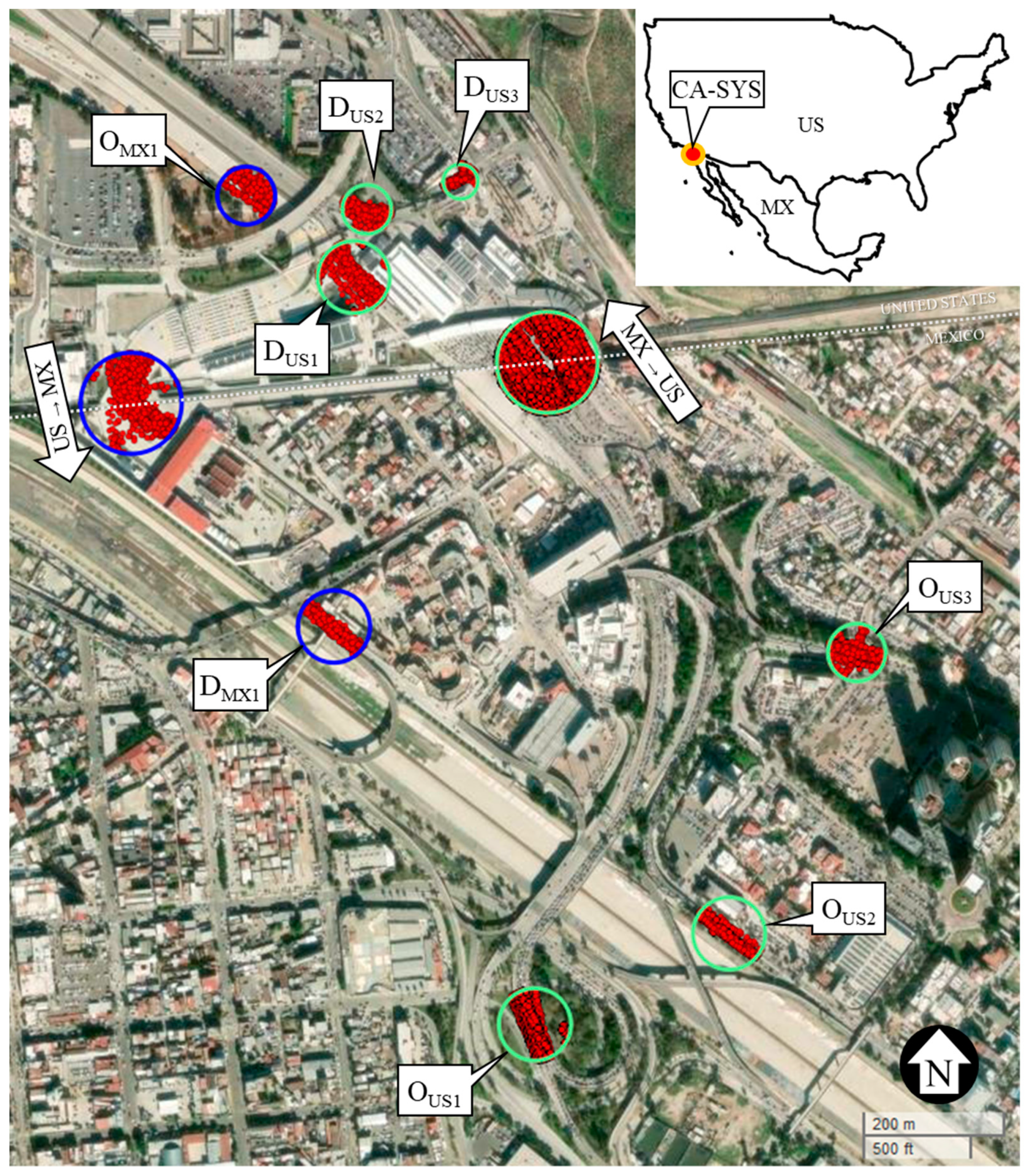
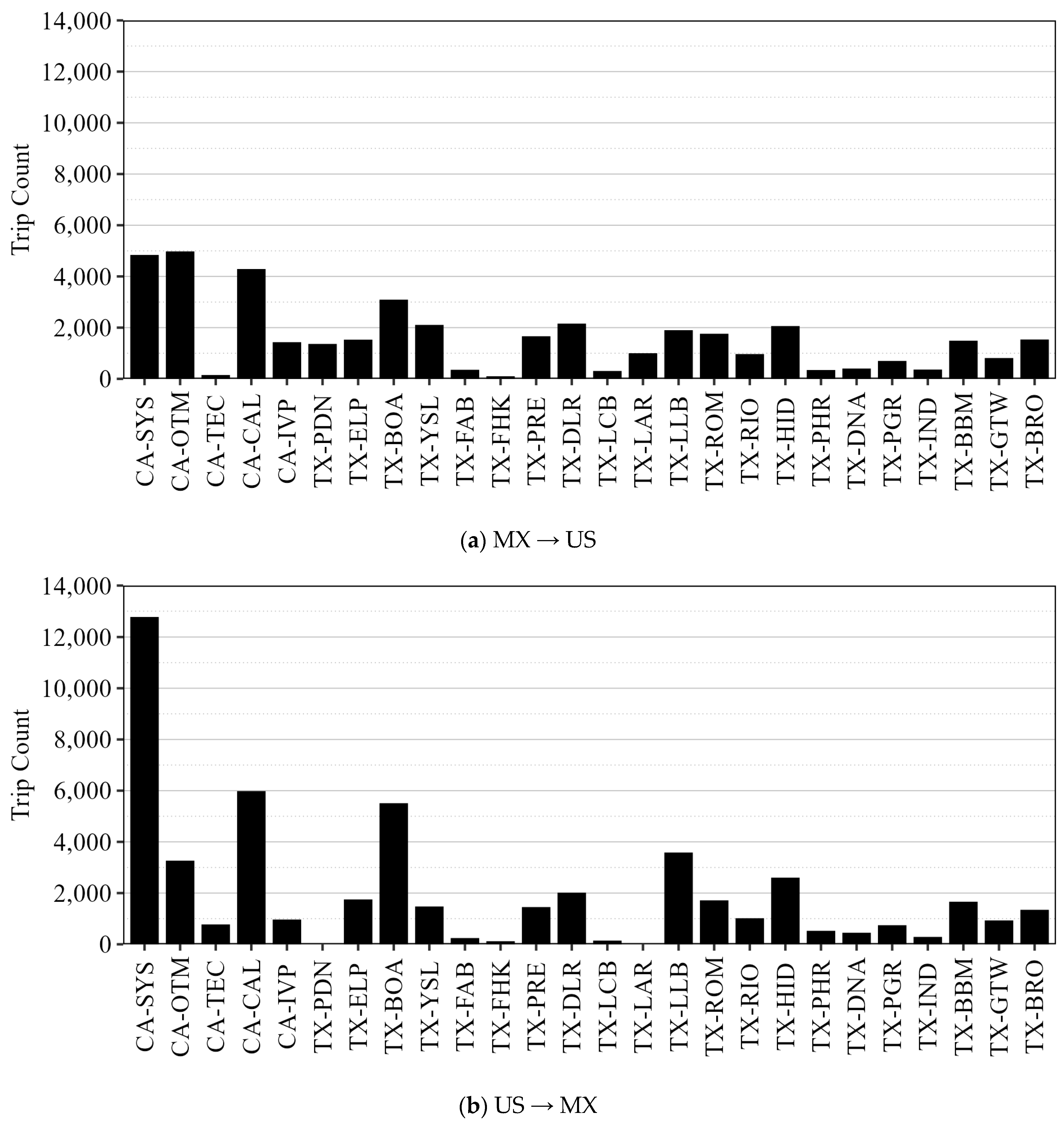
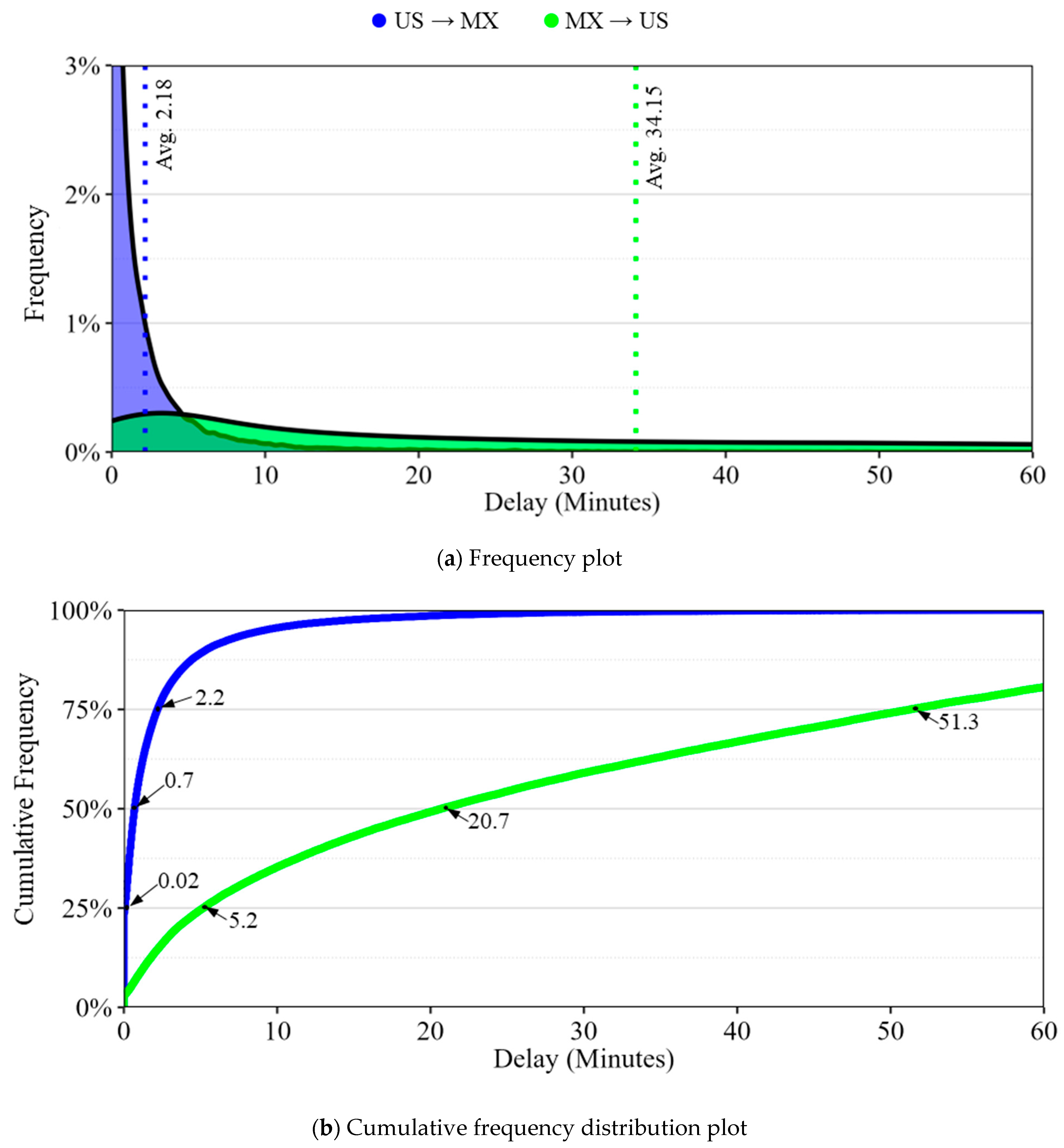
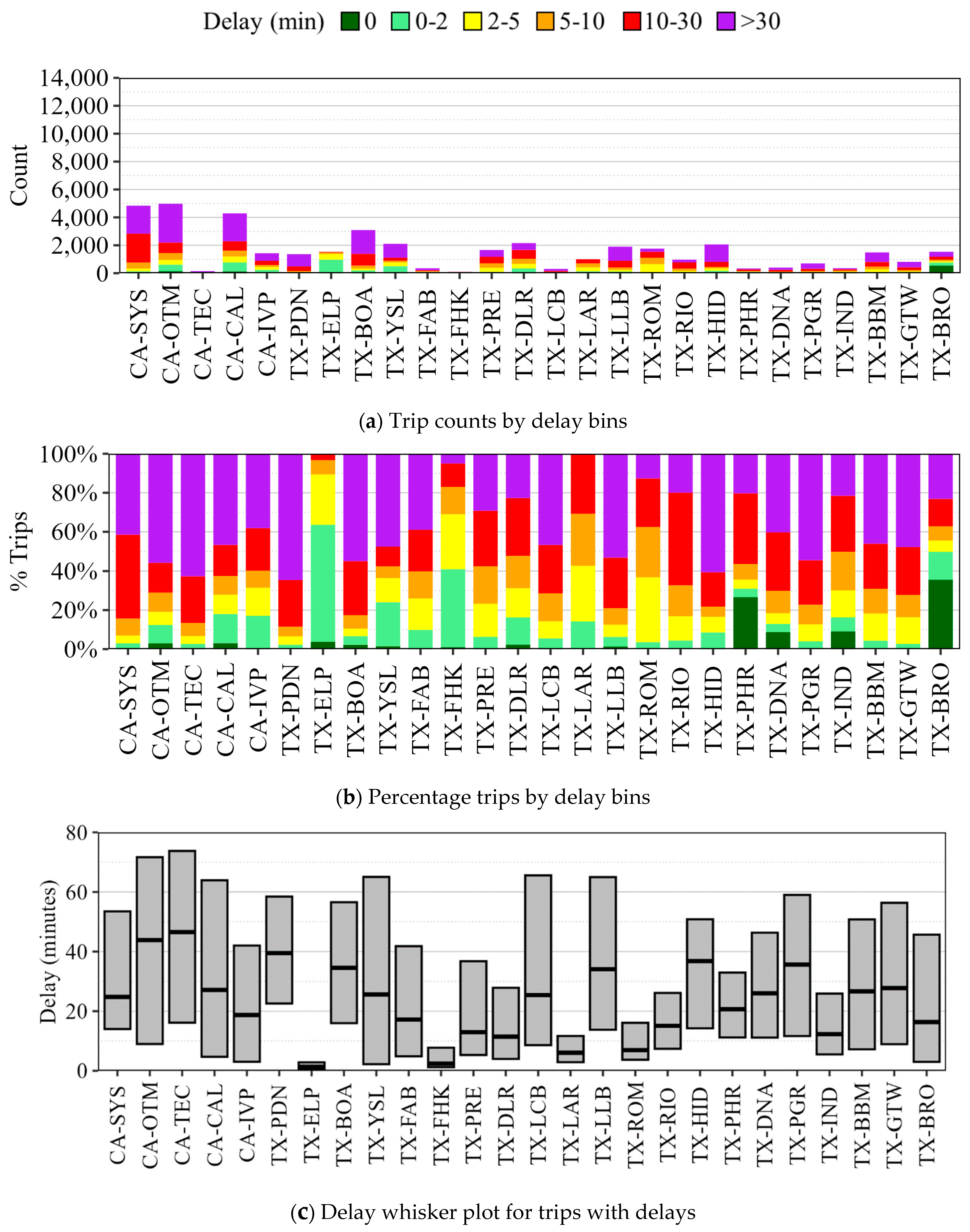
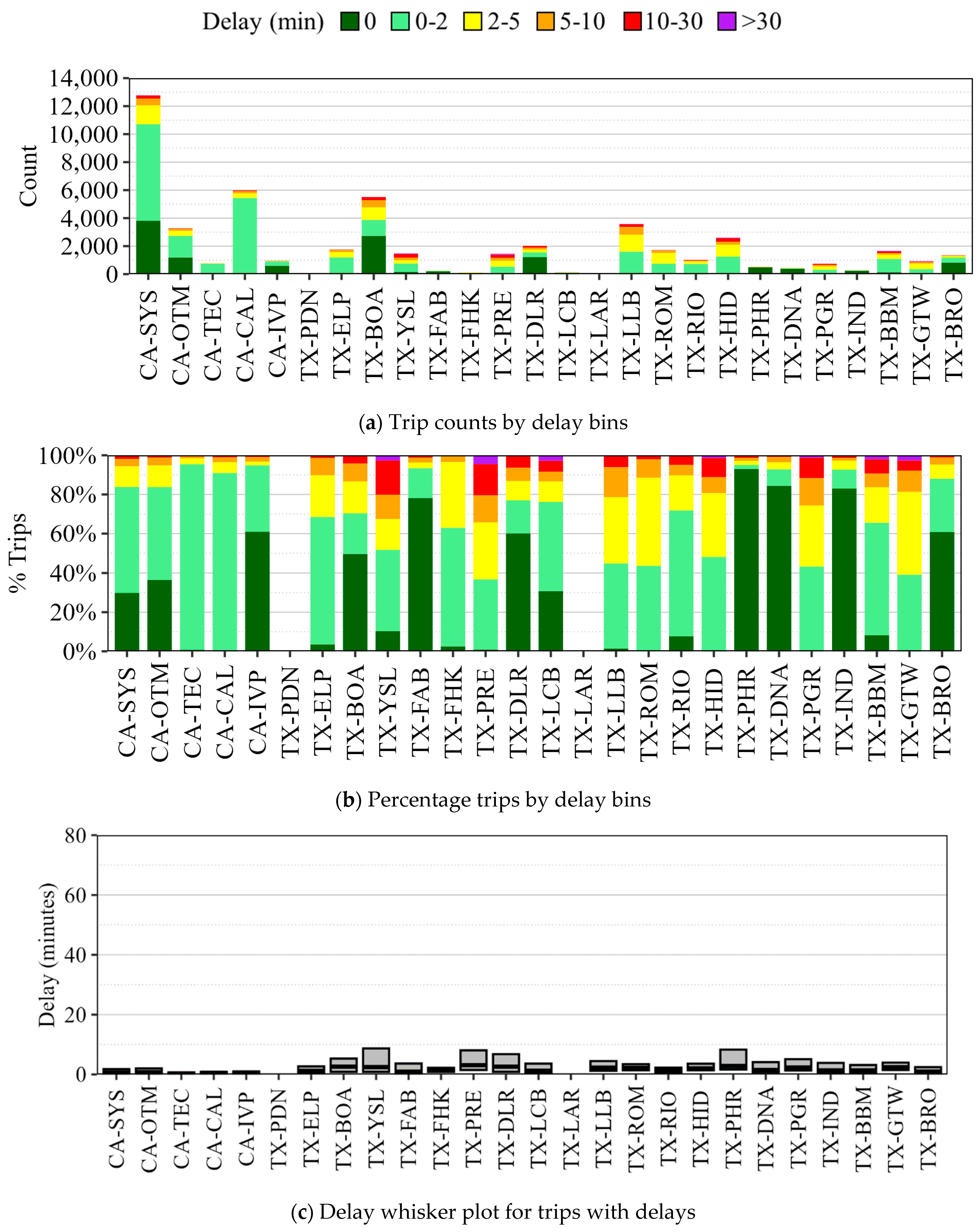
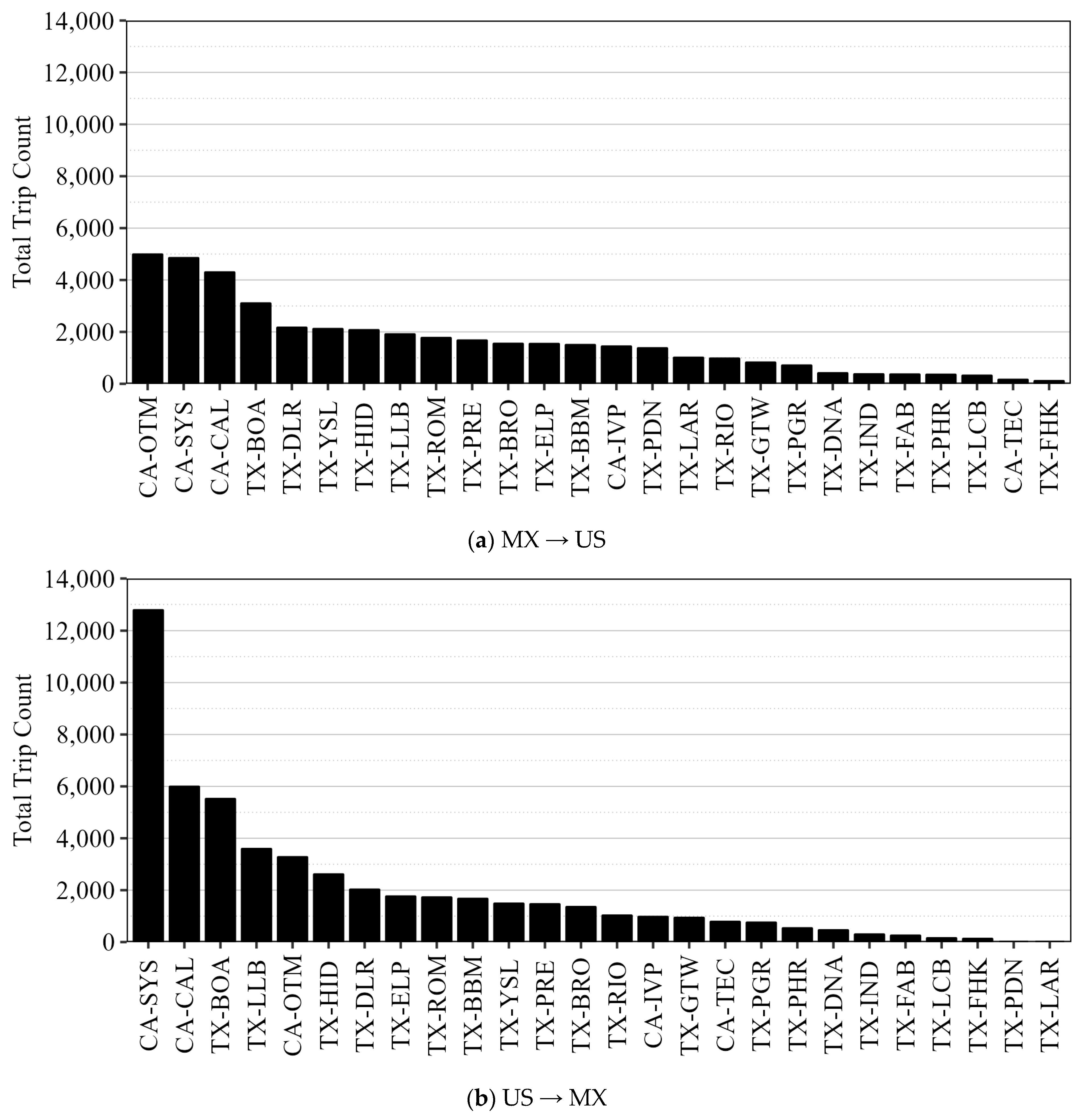
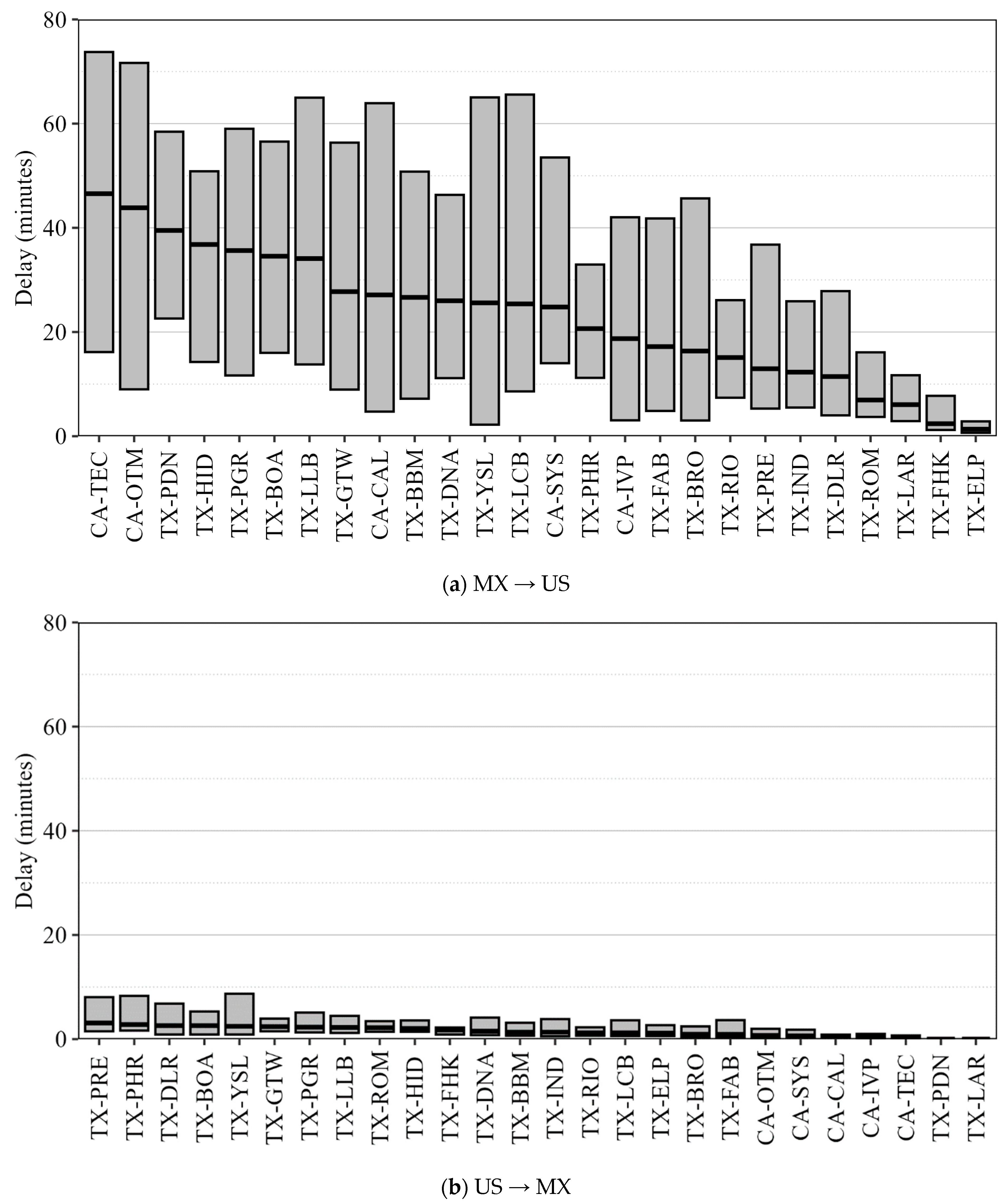
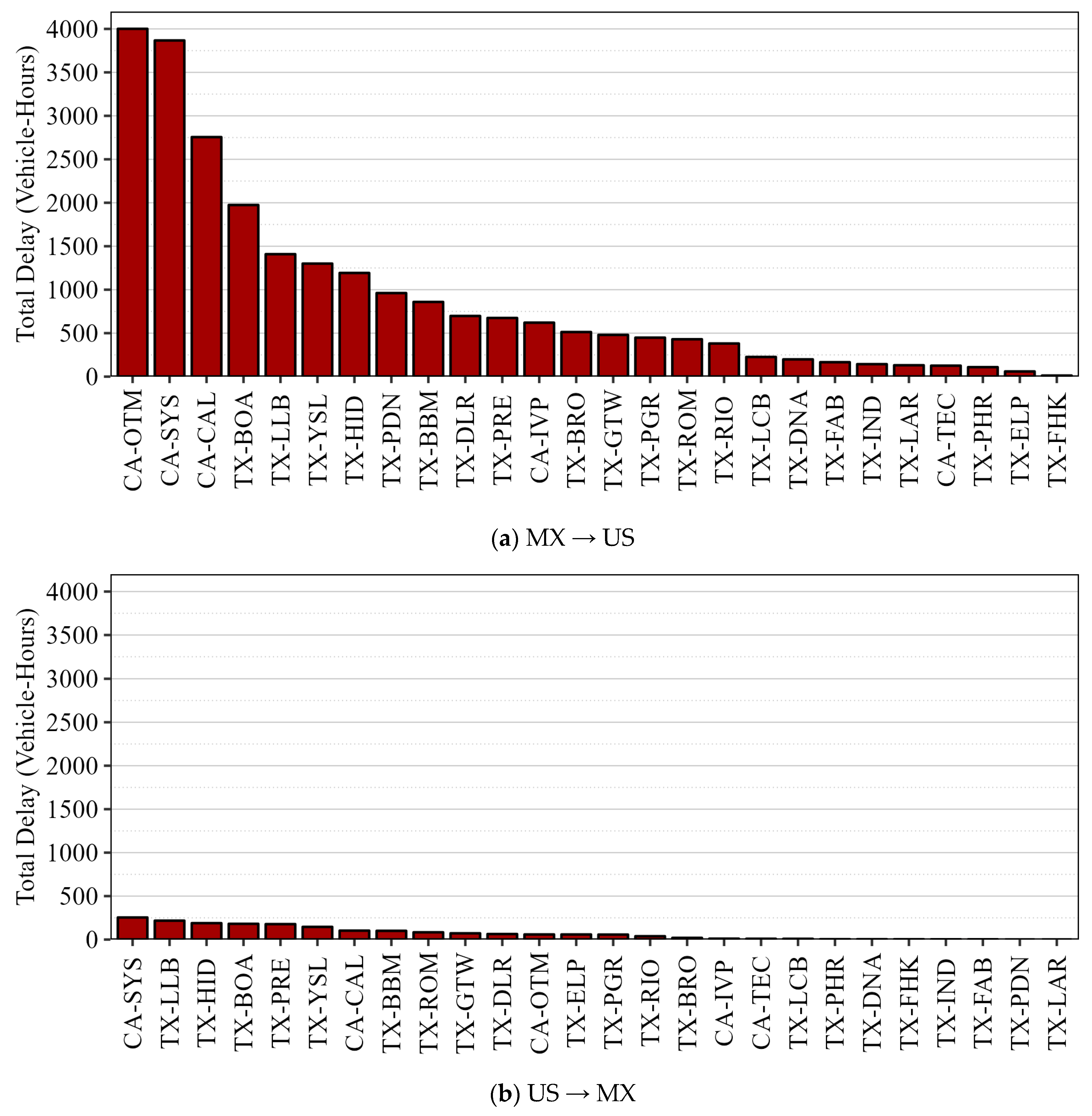
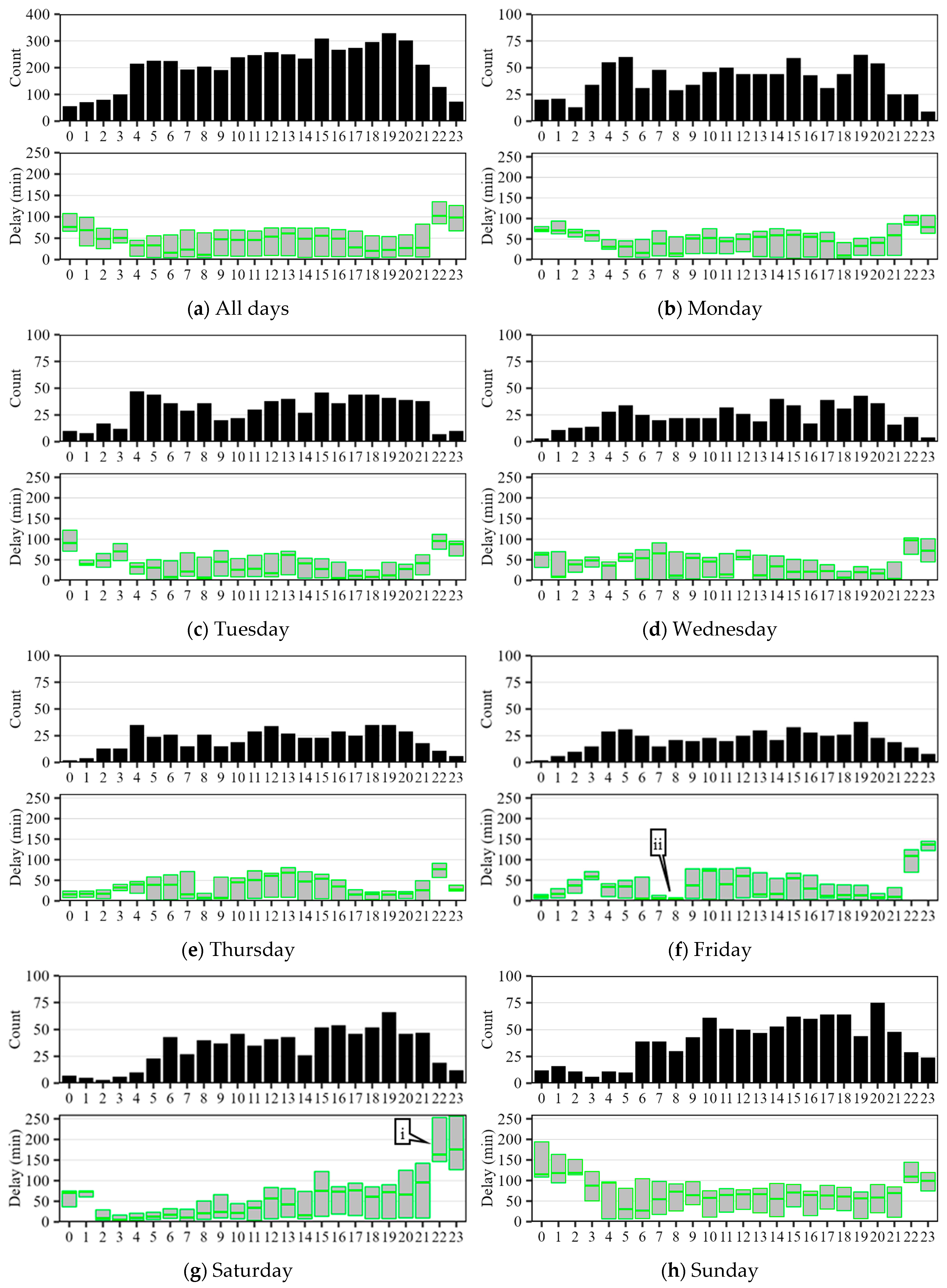
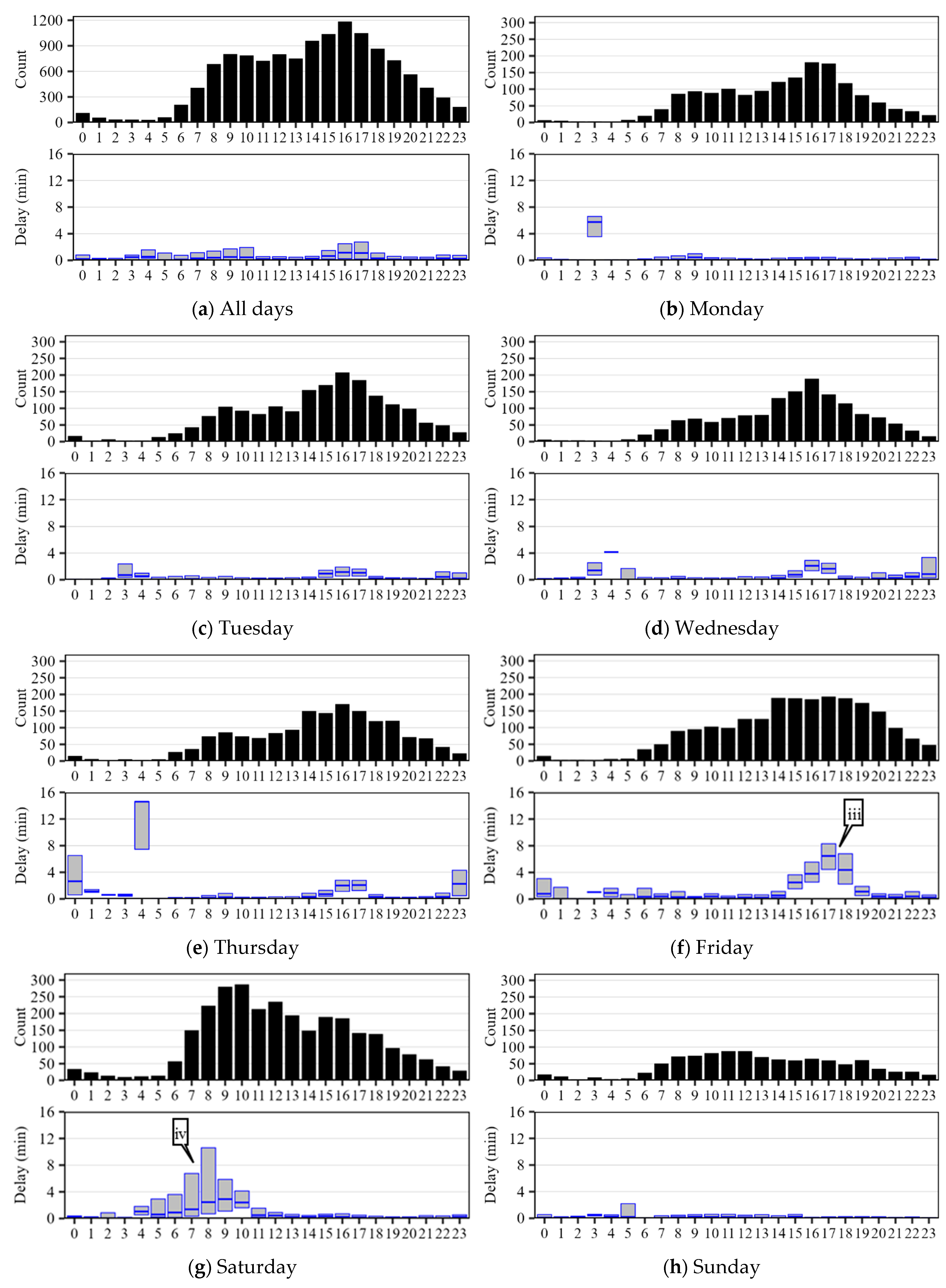
| US State | Mexico State | US Code | US Port of Entry | US Road/Highway | Mexico Port of Entry | Mexico Road/Highway | Opened in Year |
|---|---|---|---|---|---|---|---|
| California (CA) | Baja California | SYS | San Ysidro | I-5 | El Chaparral | Fed. 1 | 1906 |
| OTM | Otay Mesa | SR 905 | Mesa de Otay | Boulevard Garita de Otay | 1983 | ||
| TEC | Tecate | SR 188 | Tecate | Avenida Presidente Lázaro Cárdenas | 1919 | ||
| CAL | Calexico West | Cesar Chavez Boulevard | Mexicali | Calzada de los Presidentes | 1902 | ||
| IVP | Calexico East | SR 7 | Mexicali | Boulevard Abelardo L. Rodríguez | 1996 | ||
| Texas (TX) | Chihuahua | PDN | El Paso—PDN | El Paso Street | Vial Juan Gabriel | Vial Juan Gabriel | 1898 |
| ELP | El Paso—Stanton | US 85 (Stanton St) | Lerdo | Calle Lerdo | 1898 | ||
| BOA | El Paso—BOTA | I-110 | Cordova | Fed. 45 (Avd. Abraham Lincoln) | 1967 | ||
| YSL | El Paso—Ysleta | Zaragoza Road | Zaragoza | Avenida Zaragoza | 1938 | ||
| FAB | Tornillo | FM 1109 | Guadalupe | Fed. 2 | 2014 | ||
| FHK | Fort Hancock | FM 1088 | El Porvenir | Praxedis Guerrero | 1936 | ||
| PRE | Presidio | US 67 | Ojinaga | Fed. 16 | 1917 | ||
| Coahuila | DLR | Del Rio | Loop 239 | Acuña | Francisco Javier Mina | 1919 | |
| Nuevo León | LCB | Laredo–Colombia Solidarity | SH 255 | Colombia | Nuevo Leon State Highway Spur 1 | 1991 | |
| Tamaulipas | LAR | Laredo Bridge 1 | Convent Ave | Nuevo Laredo | Avenida Guerrero | 1898 | |
| LLB | Laredo Juarez/ Lincoln | I-35 (San Dario Avenue) | Nuevo Laredo | Boulevard Leandro Valle | 1976 | ||
| ROM | Roma | Estrella Street | Miguel Aleman | Avenida Venustiano Carranza | 1928 | ||
| RIO | Rio Grande City | Pete Díaz Avenue | Camargo | Boulevard Ensenada | 1905 | ||
| HID | Hidalgo | US 281 | Reynosa | Luis Echeverria Alvarez | 1905 | ||
| PHR | Pharr | South Cage Boulevard | Reynosa | Fed. 40 | 1994 | ||
| DNA | Donna | FM 493 | Río Bravo | Carretera Reynosa-Matamoros | 2010 | ||
| PGR | Progreso | FM 1015 | Nuevo Progreso | Benito Juarez | 1952 | ||
| IND | Los Indios | Cantu Road | Lucio Blanco | Carretera Reynosa-Matamoros | 1992 | ||
| BBM | Brownsville—B&M | Mexico Street | Matamoros | Las Americas | 1909 | ||
| GTW | Brownsville—Gateway | SH 4 (International Boulevard) | Matamoros | Alvaro Obregon | 1926 | ||
| BRO | Brownsville—Veterans | I-69E/US 77/US 83 | Matamoros | Avenida 5 de Mayo | 1999 |
| Date | Origin Time | OD Pair | Travel Time (min) |
|---|---|---|---|
| 3 August 2020 | 19:31:42 | 56.5 | |
| 22 August 2020 | 14:18:39 | 30 | |
| 20 August 2020 | 08:45:34 | 14 | |
| 25 August 2020 | 06:18:12 | 8.95 | |
| 7 August 2020 | 17:32:16 | 5.35 | |
| 11 August 2020 | 13:16:51 | 4.1 | |
| 2 August 2020 | 11:53:18 | 2.27 | |
| 21 August 2020 | 17:31:12 | 8.87 |
| Rank | Border Crossing | Trips (MX → US) | Trips Delay < 2 min | Trips Delay 2–5 min | Trips Delay 5–10 min [a] | Trips Delay 10–30 min [b] | Trips Delay ≥ 30 min [c] | Ranking by Trips Delay ≥ 5 min [a + b + c] |
|---|---|---|---|---|---|---|---|---|
| 1 | CA-SYS | 4840 | 143 (3.0%) | 192 (4.0%) | 420 (8.7%) | 2077 (42.9%) | 2008 (41.5%) | 4505 (93.1%) |
| 2 | CA-OTM | 4978 | 616 (12.4%) | 336 (6.7%) | 488 (9.8%) | 755 (15.2%) | 2783 (55.9%) | 4026 (80.9%) |
| 3 | CA-CAL | 4289 | 774 (18.0%) | 423 (9.9%) | 410 (9.6%) | 678 (15.8%) | 2004 (46.7%) | 3092 (72.1%) |
| 4 | TX-BOA | 3093 | 204 (6.6%) | 121 (3.9%) | 212 (6.9%) | 854 (27.6%) | 1702 (55.0%) | 2768 (89.5%) |
| 5 | TX-HID | 2062 | 177 (8.6%) | 165 (8.0%) | 106 (5.1%) | 364 (17.7%) | 1250 (60.6%) | 1720 (83.4%) |
| Rank | Border Crossing | Trips (US → MX) | Trips Delay < 2 min | Trips Delay 2–5 min | Trips Delay 5–10 min [a] | Trips Delay 10–30 min [b] | Trips Delay ≥ 30 min [c] | Ranking by Trips Delay ≥ 5 min [a + b + c] |
|---|---|---|---|---|---|---|---|---|
| 1 | TX-LLB | 3583 | 1610 (44.9%) | 1207 (33.7%) | 548 (15.3%) | 200 (5.6%) | 18 (0.5%) | 766 (21.4%) |
| 2 | TX-BOA | 5510 | 3880 (70.4%) | 895 (16.2%) | 502 (9.1%) | 228 (4.1%) | 5 (0.1%) | 735 (13.3%) |
| 3 | CA-SYS | 12,773 | 10,712 (83.9%) | 1348 (10.6%) | 478 (3.7%) | 224 (1.8%) | 11 (0.1%) | 713 (5.6%) |
| 4 | TX-HID | 2603 | 1253 (48.1%) | 848 (32.6%) | 211 (8.1%) | 256 (9.8%) | 35 (1.3%) | 502 (19.3%) |
| 5 | TX-PRE | 1453 | 535 (36.8%) | 420 (28.9%) | 200 (13.8%) | 233 (16.0%) | 65 (4.5%) | 498 (34.3%) |
Disclaimer/Publisher’s Note: The statements, opinions and data contained in all publications are solely those of the individual author(s) and contributor(s) and not of MDPI and/or the editor(s). MDPI and/or the editor(s) disclaim responsibility for any injury to people or property resulting from any ideas, methods, instructions or products referred to in the content. |
© 2024 by the authors. Licensee MDPI, Basel, Switzerland. This article is an open access article distributed under the terms and conditions of the Creative Commons Attribution (CC BY) license (https://creativecommons.org/licenses/by/4.0/).
Share and Cite
Sakhare, R.S.; Desai, J.; Saldivar-Carranza, E.D.; Bullock, D.M. Methodology for Monitoring Border Crossing Delays with Connected Vehicle Data: United States and Mexico Land Crossings Case Study. Future Transp. 2024, 4, 107-129. https://doi.org/10.3390/futuretransp4010007
Sakhare RS, Desai J, Saldivar-Carranza ED, Bullock DM. Methodology for Monitoring Border Crossing Delays with Connected Vehicle Data: United States and Mexico Land Crossings Case Study. Future Transportation. 2024; 4(1):107-129. https://doi.org/10.3390/futuretransp4010007
Chicago/Turabian StyleSakhare, Rahul Suryakant, Jairaj Desai, Enrique D. Saldivar-Carranza, and Darcy M. Bullock. 2024. "Methodology for Monitoring Border Crossing Delays with Connected Vehicle Data: United States and Mexico Land Crossings Case Study" Future Transportation 4, no. 1: 107-129. https://doi.org/10.3390/futuretransp4010007
APA StyleSakhare, R. S., Desai, J., Saldivar-Carranza, E. D., & Bullock, D. M. (2024). Methodology for Monitoring Border Crossing Delays with Connected Vehicle Data: United States and Mexico Land Crossings Case Study. Future Transportation, 4(1), 107-129. https://doi.org/10.3390/futuretransp4010007








